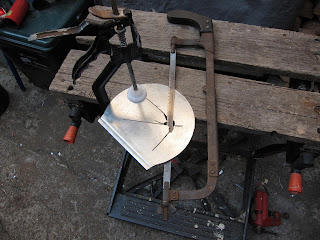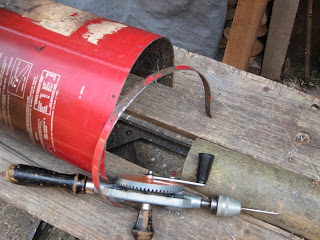What I now have is a cylinder.
I order to make it a closed shape I need to seal the ends, given that I'm using mostly hand tools I can only cut in straight lines. I mark out the shape I need by drawing the profile of the barrel directly onto the metal.
to save a little work I kept the circle as close to the pre cut edges as possible.....
And proceeded to making it into as much of a circle as possible, Just keep hacking off more and more straight bits. More sawing and more filing to take off the edges and it becomes a the disk-esqe shape needed..
I had already curved over the edges of a piece of metal to make the top plate, I kept trying it in for the fit.
Of course it still has to secured in place, where I shall be making more mistakes.
To make the hole where the door will go, here I come across another of the hacksaws limitations. I can't simply cut across the metal without ruining it, I begin by drilling big old hole to feed the saw blade through, I reassemble the saw and slowly resume the sawing.
after finally managing to get the hole resembling a square I cut diagonally into the corners, Later I bend it over ( and out) to make the door frame, removing so much metal makes it bendy, adding the frame will give back some strength.
Now to the other end, where the Exhaust pipe will be going
I order to make it a closed shape I need to seal the ends, given that I'm using mostly hand tools I can only cut in straight lines. I mark out the shape I need by drawing the profile of the barrel directly onto the metal.
And in time a pair of disks.. you can see where I've started to mark out the door on the first disk.
I took quite a lot of filing and tweaking to get a nice close fit to the cylinders sides.
I had already curved over the edges of a piece of metal to make the top plate, I kept trying it in for the fit.
Of course it still has to secured in place, where I shall be making more mistakes.
To make the hole where the door will go, here I come across another of the hacksaws limitations. I can't simply cut across the metal without ruining it, I begin by drilling big old hole to feed the saw blade through, I reassemble the saw and slowly resume the sawing.
after finally managing to get the hole resembling a square I cut diagonally into the corners, Later I bend it over ( and out) to make the door frame, removing so much metal makes it bendy, adding the frame will give back some strength.
Now to the other end, where the Exhaust pipe will be going
































